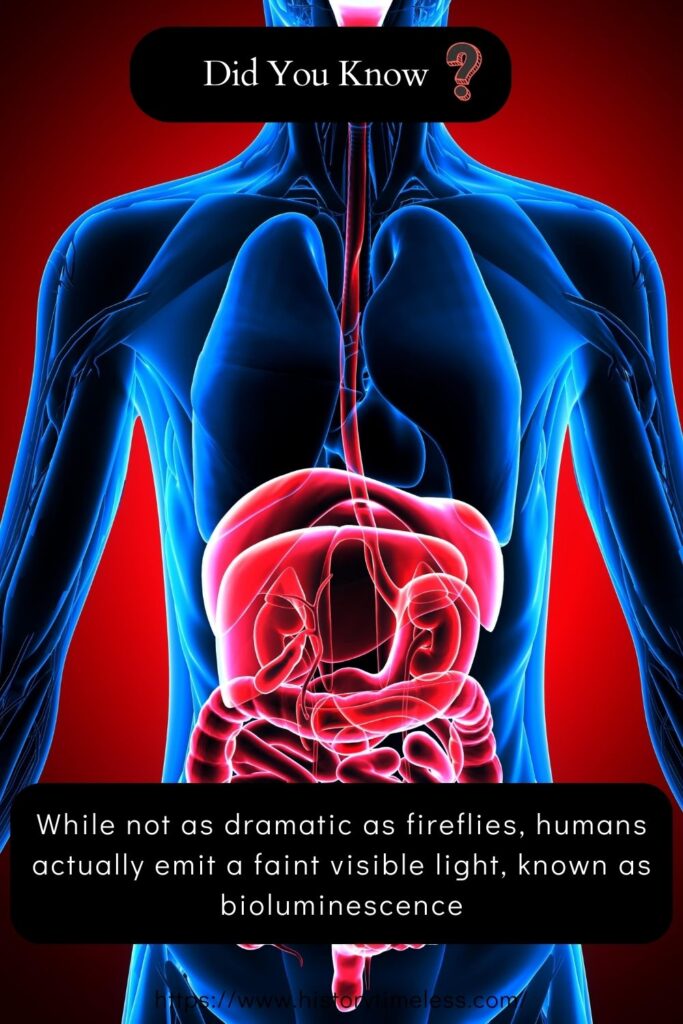Get ready to explore some intriguing and relatable facts that might just change how you see yourself and the people around you.
These insights will touch upon various aspects of human existence, aiming to be both informative and engaging for your viewers. Let’s get started with these captivating glimpses into what makes us human.
1. Humans are Bio-Luminescent, Emitting a Faint Light
While not as dramatic as fireflies, humans actually emit a faint visible light, known as bioluminescence. This light is thousands of times weaker than what our naked eyes can perceive and is a byproduct of biochemical reactions in our cells, specifically from free radicals reacting with lipids and proteins.

Using highly sensitive cameras in dark rooms, scientists have captured this faint glow, which appears to be strongest around the forehead, neck, and cheeks and fluctuates throughout the day, often being lowest in the late afternoon and highest around midnight.
2. We Spend Roughly a Third of Our Lives Asleep
Sleep is not just downtime; it’s a fundamental biological necessity. On average, humans spend about a third of their lives sleeping. This seemingly passive state is actually a period of intense activity for our bodies and brains.
During sleep, our bodies repair tissues, consolidate memories, and regulate hormones crucial for growth and appetite.
Sleep deprivation can lead to a host of problems, from impaired cognitive function and weakened immunity to increased risk of chronic diseases, highlighting the vital role sleep plays in our overall health and well-being.
3. Human Brains Can Generate Enough Electricity to Power a Small Lightbulb
The human brain, with its billions of neurons firing electrical signals, is a surprisingly powerful organ. While it only consumes about 20 watts of power, roughly the same as a dim lightbulb, the collective electrical activity of neurons firing simultaneously could theoretically generate enough electricity to power a small LED lightbulb for a short time.
This electrical activity is the basis of our thoughts, emotions, and actions, showcasing the incredible energy and complexity packed within our skulls.
4. Babies Have More Bones Than Adults at Birth
It may seem counterintuitive, but babies are born with around 300 bones, significantly more than the 206 bones an average adult possesses.
This is because many of a baby’s bones are initially made of cartilage and are in smaller segments. As we grow, many of these bones fuse together through a process called ossification.
This greater number of bones in infants allows for more flexibility during birth and rapid growth in the early years of life. These separate bones gradually join to form the adult skeletal structure.
5. Sneezes Can Travel Up to 100 Miles Per Hour
When we sneeze, we expel air, saliva, mucus, and potentially germs at incredible speeds. A sneeze can travel at speeds ranging from 30 to 100 miles per hour, propelling droplets a considerable distance – sometimes several feet.
This forceful expulsion is a reflex action designed to clear irritants and pathogens from our respiratory system.
Covering your mouth and nose when you sneeze is crucial to prevent the spread of germs and protect those around you from potential illness.
6. Humans Can Recognize Trillions of Different Smells
Our sense of smell is far more sophisticated than we often realize. While we used to believe humans could only distinguish around 10,000 different odors, newer research suggests we can actually differentiate at least one trillion different smells.
Our olfactory system, with its millions of receptors, is incredibly sensitive and plays a significant role in taste, memory, and even emotional responses. This vast olfactory landscape enriches our experience of the world in subtle yet profound ways.
7. Stomach Acid is Strong Enough to Dissolve Metal
The hydrochloric acid in our stomachs is incredibly potent, with a pH of 1.5 to 3.5 – strong enough to dissolve some metals, like a razor blade over time.
This highly acidic environment is essential for breaking down food, killing bacteria, and aiding in digestion.
However, the stomach lining is protected by a layer of mucus that constantly regenerates, preventing the acid from digesting the stomach itself. This powerful acid highlights the robust chemical processes occurring within our digestive system.
8. Our Brains Process Visual Information Upside Down
Interestingly, the images projected onto our retinas at the back of our eyes are actually upside down and backward. It’s the brain that takes this inverted information and flips it right-side up, allowing us to perceive the world correctly.
This complex processing happens instantaneously and unconsciously. This remarkable feat of neural interpretation demonstrates the brain’s incredible ability to make sense of the sensory data it receives and construct our perception of reality.
9. Humans Share 50% of Their DNA with Bananas
It might sound surprising, but humans share approximately 50% of their DNA with bananas. This doesn’t mean we are half banana, but rather reflects the shared ancestry of all life on Earth and the fundamental similarities in basic biological processes across different species.
Many genes are highly conserved throughout evolution, performing essential functions in cell maintenance, metabolism, and growth. This shared genetic heritage underscores the interconnectedness of all living things.
10. The Average Person Walks the Equivalent of Five Times Around the Earth in a Lifetime
Over an average lifetime, a person walking the recommended 10,000 steps per day will cover a distance equivalent to walking around the Earth roughly five times.
This staggering distance highlights the cumulative effect of our daily movements. Walking is not just a mode of transportation; it’s a fundamental human activity that contributes to our health, well-being, and exploration of the world around us, adding up to an incredible journey over the course of a life.
11. We Have an Internal Clock that Operates on a Roughly 24-Hour Cycle
Our bodies are governed by an internal biological clock, known as the circadian rhythm, which operates on a roughly 24-hour cycle. This clock regulates various physiological processes, including sleep-wake cycles, hormone release, body temperature, and digestion.

It’s primarily influenced by light and darkness, helping us synchronize our internal processes with the day-night cycle of our environment.
Disruptions to this clock, such as jet lag or shift work, can have significant impacts on our health and well-being.
12. Human Skin Regenerates Itself Approximately Every 27 Days
Our skin is constantly renewing itself. Every minute, we shed about 30,000 to 40,000 dead skin cells. Over a period of roughly 27 days, our skin completely regenerates, replacing old skin cells with new ones.
This continuous process of shedding and renewal is crucial for maintaining the skin’s protective barrier, repairing damage, and keeping our largest organ healthy and functional throughout our lives.
13. Crying Can Be a Biological Response to Pain and Emotion
Humans are unique in their capacity for emotional crying. While other animals may produce tears to lubricate their eyes, humans cry in response to a range of emotions, including sadness, joy, and pain.
Tears produced during emotional crying have a different chemical composition than those produced for lubrication, containing stress hormones like cortisol and prolactin.
Crying is believed to serve as a cathartic release, signaling distress and eliciting social support, playing a role in emotional regulation and communication.
14. Our Heart Can Change Its Beat to Match the Music We Listen To
The human heart is surprisingly responsive to external stimuli, including music. Studies have shown that our heart rate can synchronize with the rhythm of the music we are listening to.
Upbeat, faster music tends to increase heart rate, while slower, calming music can have a soothing effect, slowing it down.
This physiological response highlights the deep connection between music, emotion, and our physical bodies, demonstrating the powerful influence of auditory stimuli.
15. Humans are Born with an Innate Fear of Falling and Loud Noises
Certain fears appear to be hardwired into our brains from birth. Two of the most prominent innate fears in humans are the fear of falling and the fear of loud noises.
These fears are thought to be evolutionary adaptations that helped our ancestors survive. A fear of falling would have been crucial for avoiding injuries, while a fear of loud noises could signal danger. These innate responses highlight the survival instincts that are deeply ingrained in our human nature.
16. The Human Body Contains Enough Carbon to Make 900 Pencils
The human body is composed of various chemical elements, and carbon is one of the most abundant. In fact, the average adult human body contains enough carbon to create approximately 900 pencils.
Carbon is the backbone of organic molecules, forming the basis of proteins, carbohydrates, fats, and DNA. This fact underscores the fundamental role of carbon in life and the intricate chemistry that makes up our physical being.
17. We Have ‘Goosebumps’ as a Vestigial Reflex from Our Furry Ancestors
Goosebumps, those tiny bumps that appear on our skin when we are cold or scared, are a vestigial reflex inherited from our furry ancestors.
In animals with fur, goosebumps cause the hairs to stand on end, creating a layer of insulation to trap heat and make the animal appear larger and more intimidating to predators.
In humans, with our sparse body hair, this reflex is less effective for thermoregulation or defense but remains as an evolutionary relic of our past.
18. The Human Eye Can Distinguish About 10 Million Different Colors
The human eye is capable of perceiving an impressive range of colors. With specialized cells called cones in our retinas, we can distinguish approximately 10 million different colors.
These cones are sensitive to different wavelengths of light, allowing us to experience the vibrant spectrum of colors in the world around us.
This rich color perception enhances our visual experience and plays a crucial role in our appreciation of art, nature, and visual communication.
19. Our Fingerprints are Completely Unique, Even Identical Twins Have Different Prints
Each person’s fingerprints are entirely unique, even in the case of identical twins who share nearly identical DNA.
Fingerprints are formed in the womb and are influenced by a combination of genetic and environmental factors.
The intricate patterns of ridges and valleys on our fingertips are so distinct that they have been used for centuries as a reliable method of identification. This uniqueness highlights the incredible variability and complexity of human development.
20. Humans are Social Creatures with a Deep Need for Connection
Humans are fundamentally social beings. Our need for connection and belonging is deeply ingrained in our psychology and biology. Social interaction and relationships are crucial for our emotional and mental well-being, as well as our physical health.
Loneliness and social isolation can have detrimental effects on both our minds and bodies. This inherent social nature underscores the importance of community, friendship, and love in human life.
21. Laughter is Contagious and Has Physiological Benefits
Laughter is not just an expression of joy; it’s also a contagious social behavior with significant physiological benefits. When we laugh, our bodies release endorphins, which have mood-boosting and pain-relieving effects.
Laughter can reduce stress hormones, improve immune function, and even provide a cardiovascular workout. The contagious nature of laughter highlights its social bonding function and its positive impact on our overall well-being.
22. Humans are Capable of Holding Their Breath for a Surprisingly Long Time with Training
While the average person can hold their breath for around 30 seconds to a minute, with training, humans can significantly extend this capability.
Freedivers, for instance, can hold their breath for several minutes, with world records exceeding 11 minutes.
This ability demonstrates the human body’s remarkable adaptability and the potential to push physiological limits through focused training and techniques like breath-hold exercises.
23. We Spend Years of Our Lives Dreaming
We spend a significant portion of our lives in the realm of dreams. On average, a person spends about six years of their life dreaming.
Dreams occur primarily during REM (Rapid Eye Movement) sleep and are characterized by vivid imagery, emotions, and narratives.
While the exact function of dreams is still debated, they are thought to play a role in memory consolidation, emotional processing, and even problem-solving. This vast dream world is a fascinating aspect of our subconscious experience.
24. The Human Brain is More Active During Sleep Than While Watching TV
Contrary to the notion of sleep as a passive state, the human brain is often more active during sleep than when we are watching television. Brain activity during REM sleep, in particular, is comparable to or even exceeds wakefulness in some regions.
During sleep, the brain engages in crucial processes like memory consolidation, neural network reorganization, and waste removal. This active brain state highlights the vital and dynamic nature of sleep for our cognitive function and overall health.
25. Humans are Storytelling Animals, Wired to Create and Share Narratives
Humans are inherently storytelling creatures. From ancient myths to modern novels and movies, we are driven to create and share narratives. Storytelling is a fundamental aspect of human communication, culture, and cognition.
Stories help us make sense of the world, transmit knowledge, share experiences, and connect with each other emotionally. This innate drive to narrate and listen to stories is a defining characteristic of human culture and social interaction.
26. Humans are the Only Species Known to Blush
Blushing, the involuntary reddening of the face in response to embarrassment, shame, or social anxiety, is a uniquely human phenomenon.
While the exact evolutionary purpose of blushing is still debated, it is believed to be a social signal, communicating embarrassment and potentially defusing conflict or eliciting empathy.
This visible display of emotion highlights the complex social and emotional lives of humans and our capacity for self-awareness and social signaling.
Discover more interesting facts:
30 Dark Tales Where Fate Takes a Shocking Turn!
20+ Bizarre Medical Mysteries That’ll Leave You Speechless!
25 Shocking Secrets of Ancient Rome You Never Knew!
10+ Amazing Zodiac Facts About Libra Women




